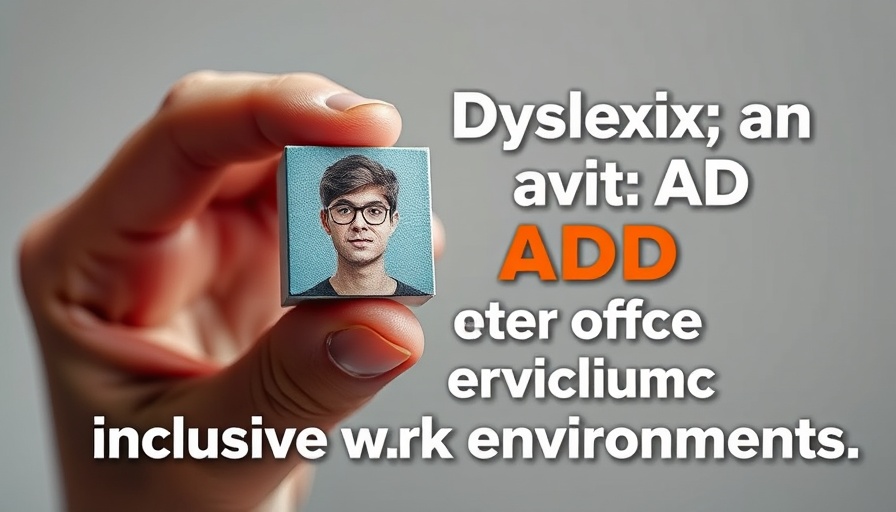
Understanding Neurodiversity: A Journey Toward Acceptance
In a world that often adheres to a rigid definition of normalcy, gaining insight into the experiences of those who are neurodivergent is crucial for fostering understanding and acceptance. This need for awareness is underscored in the insightful discussion presented in James Driver on Dyslexia, Finding ADHD & Creating Inclusive Work Environments, where James shares his unique journey as a neurodivergent individual navigating both life and work.
In 'James Driver on Dyslexia, Finding ADHD & Creating Inclusive Work Environments', the discussion dives into the challenges and triumphs of neurodiversity, prompting an exploration of meaningful insights.
The Power of Labels: More than Just a Diagnosis
James recounts his early struggles with dyslexia—an encounter that made him feel "stupid" in a system not designed to support individual differences. Sadly, he was not alone; many neurodivergent individuals face similar challenges where labels exist but the support often falls short. The importance of accurate labeling can lead to better support systems, allowing individuals to understand their unique challenges and strengths. In James' case, he’s currently exploring the possibility of ADHD, illustrating a dynamic journey of self-discovery, as many neurodivergent individuals can relate. Having a diagnosis can empower one to seek the right resources and support, transforming stigma into strength.
Breaking Down Barriers: Challenges in Education and Employment
James' experiences in the workplace reveal systemic barriers that often leave neurodivergent individuals feeling isolated or misunderstood. Employers may not fully grasp how to engage with neurodivergent employees, which can affect both morale and productivity. The conversation around creating inclusive environments is vital; not just for the individual, but for the workplace culture as a whole. By encouraging open dialogue about neurodiversity, companies can cultivate an atmosphere that embraces differences. For parents and educators, recognizing these challenges within academic settings is equally important. Understanding how certain teaching methods can inhibit, rather than enhance, learning for neurodivergent students is essential.
Fostering Inclusion: The Role of Policies and Education
As James delves into how organizations can create inclusive work environments, we get a glimpse into the significance of policies that recognize neurodiversity. He highlights the establishment of Employee Resource Groups (ERGs), which can be critical in driving these conversations. Such groups provide safe spaces for individuals to share their experiences and offer input on what support systems should be in place. For educators and school administrators, establishing a similar framework within schools can create a supportive network for students who may feel marginalized or unsupported.
Success Stories: The Impact of Support and Understanding
James' journey showcases the power of understanding and support in allowing neurodivergent individuals to thrive. Through a supportive work environment, he was able to disclose his challenges without fear of repercussion, leading to open conversations about reasonable accommodations. This culture of acceptance can have a profound effect not only on individual performance but also fosters a sense of community and belonging. By implementing initiatives like accessibility passports, organizations can ensure neurodivergent employees receive tailored support that acknowledges their unique ways of working.
Taking Proactive Steps: Empowering Parents and Teachers
For parents and educators, the journey towards understanding and embracing neurodiversity starts with education. Here are actionable insights for creating a more supportive environment for neurodivergent children:
- Educate Yourself: Understanding various neurodivergent conditions can distinctly impact how one approaches learning and discipline.
- Build Support Networks: Collaborate with other parents, teachers, and professionals to share resources and experiences.
- Create Inclusive Classrooms: Adopt teaching methods that cater to diverse learning needs, empowering students to express their unique perspectives.
Recognizing and celebrating differences is not just about being aware; it is about creating an inclusive society that allows everyone to flourish.
Conclusion: The Path Forward
As James shares his story, it becomes clear that embracing neurodiversity is a journey that requires understanding, compassion, and action. By promoting conversations around neurodiversity, not only can we support individuals in their quest for acceptance, but we also create workplaces and classrooms where everyone can thrive. Let's continue to break down the barriers, foster acceptance, and empower our neurodiverse populations. If you are a parent or educator, actively engage with your children and students about their unique challenges and strengths. Remember, your understanding can make all the difference.
 Add Row
Add Row  Add
Add 




 Add Row
Add Row  Add
Add 

Write A Comment